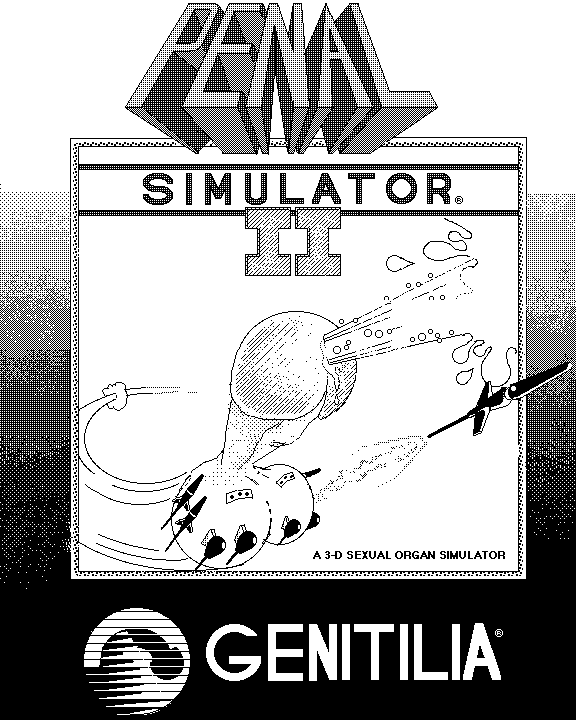
Today is animation frame day. After today, when this week's old mac art-centered blog is over, I can go back to regular blogging. First, I'll post a couple of sets of frames for a planned skateboarding animation. Animations never turned out as well as I'd imagine them when I drew the frames. I don't think I was ever a very good animator; I didn't know how to time the frames, set the frame rate, how much distance to put between moving frames, etc. The static images of the frames, pre-animation, are actually cooler than any animation I might have made out of them (or could re-make now, using flash).
I think computers just got too complicated for me. My crowning achievements in mac ownership were in superpaint, videoworks, and world builder (with which I made an adventure game called 'gene's quest'). Here are the frames for my planned skateboard animation.
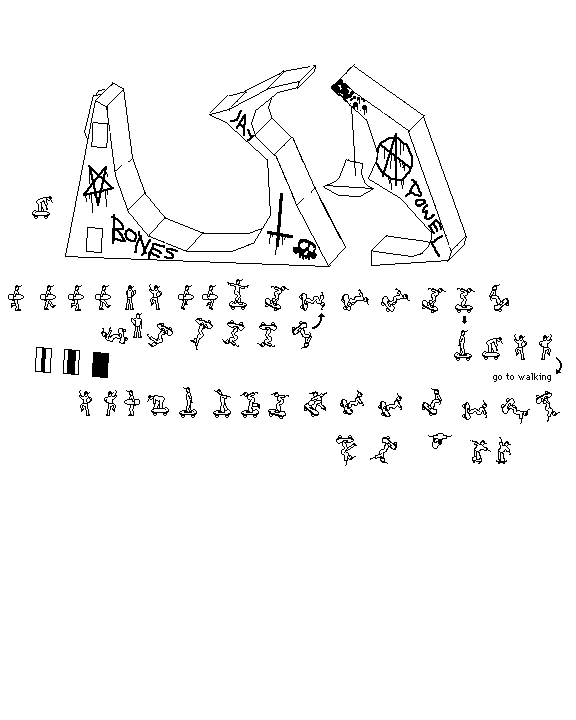
Cute, eh? I had planned to have that little dude skate around the ramp, and then eventually launch off the ramp that points towards the viewer. For this, I needed a second set of frames.
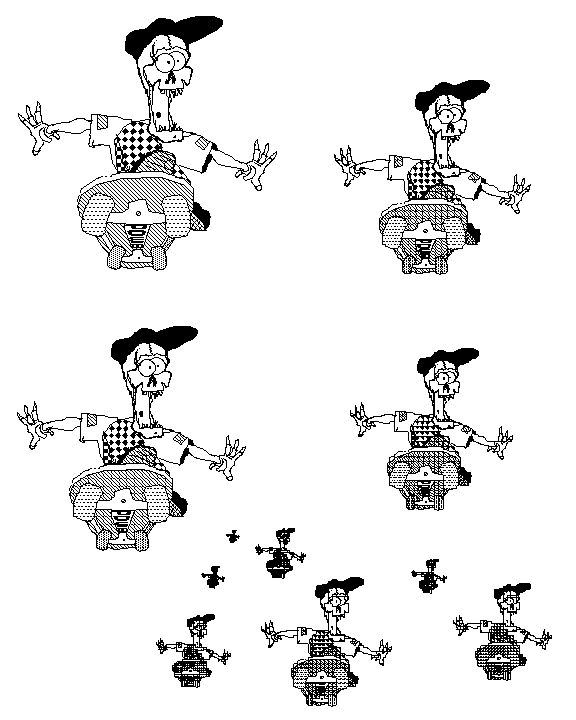
Next is the sequel to a game concept that nick and I had in 6th grade (or around then). We made an animation called 'superquan,' and it was made to look like the 'demo' screen of a primitive video game. It constituted a man in a ninja outfit jumping up against a wall and smashing bricks with his sword. Later (probably in 9th grade?) I made a sequel to superquan called (!) 'superquan 2.' I think it was supposed to reflect the changing of the times in terms of video game graphics.
As always, though, the animation didn't turn out anywhere near as nicely as the static frames. So, here they are.
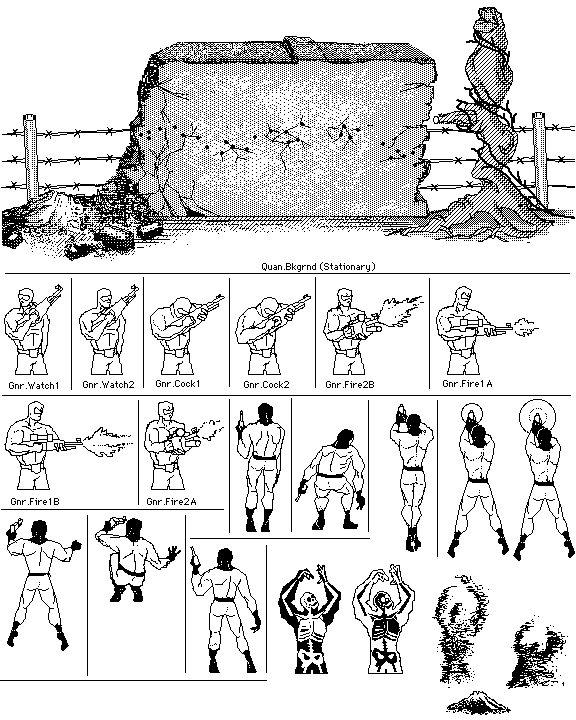
Finally, a dude getting cut in half.
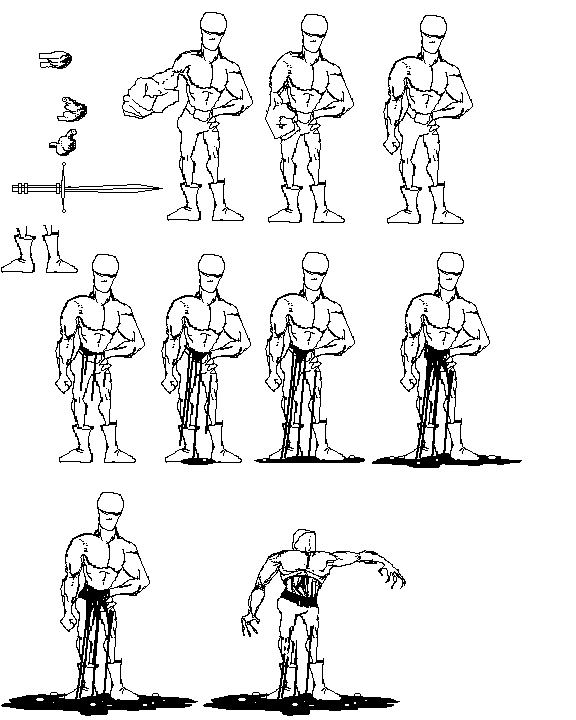
That's it. Wow, what a week.
Here's my most recent insight about my brain damage: I may be smarter, more creative, more capable, etc, than 99% of people, but I am still not good enough, and the cause of this deficit is my brain injury. It's actually quite depressing to see all of this artwork that I did, and think about how perfectly fluent I was with those tools, and compare it to how clumsy my use of contemporary graphics programs is. I think it's a combination of the programs getting more complicated and more specialized, my inspiration leaving me (I'm not as willing to put as much time and effort on things as I used to be), and my brain injury, which makes it harder to learn new software.
This week has turned out to be 'old mac art week.' today's image constituted an attempt to start a teenage macintosh users group. The bulletin was never printed or posted anywhere. I suppose that the drawing of the members of the band 'danzig' would have worked to draw in the attention of anyone (including teenaged mac users), but it's sort of a strange association. For one thing, I imagine the intersection between the sets of mac-users and danzig-listeners to be very small (drawn from a photograph of the band, mac fonts).
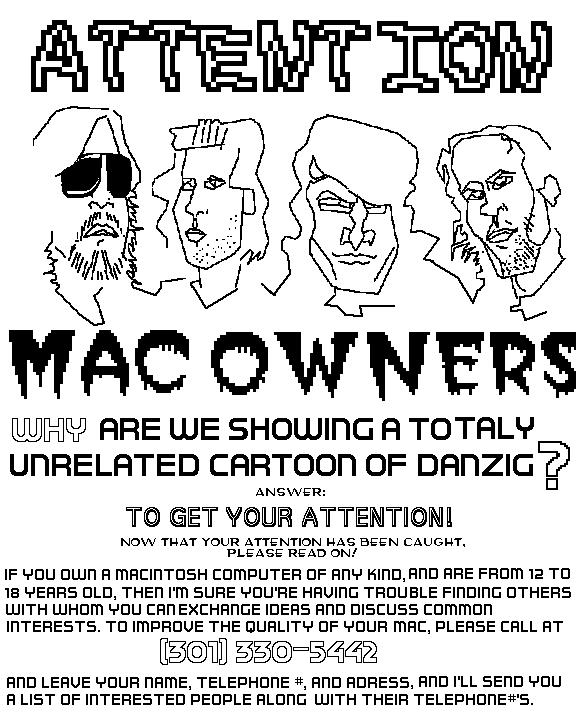
I'm going to go ahead and post all of my old macintosh drawings, just so I can fit them all into this week's blog. The presence of the images (and the knowledge that there are more that need to be posted) makes it harder to devote my time and energy to developing written content, which is 'what this blog is all about.' hehe.
Next is a picture of an uzi. I copied the gun from the 'illustrated encyclopedia of firearms' (i loved illustrated encyclopedias, and had one on the subject of firearms, mushrooms, helicopters, animals, etc). Many of these old mac drawings are at least partially copied from some other source, something that I used to enjoy doing. I supposed copying other people's artwork or photographs is akin to being a musician and covering someone else's song; there's artistic merit to it, especially if the copy is clearly one's own interpretation of the work. I find that a lot of young artists spend a lot of time copying things. I suppose this is the way they develop their skills. Also in my defense, I tended to copy photographs, which is only a step away from life drawing (drawn from a photograph. Skull insignia, flying bullets, and speech bubble are original).
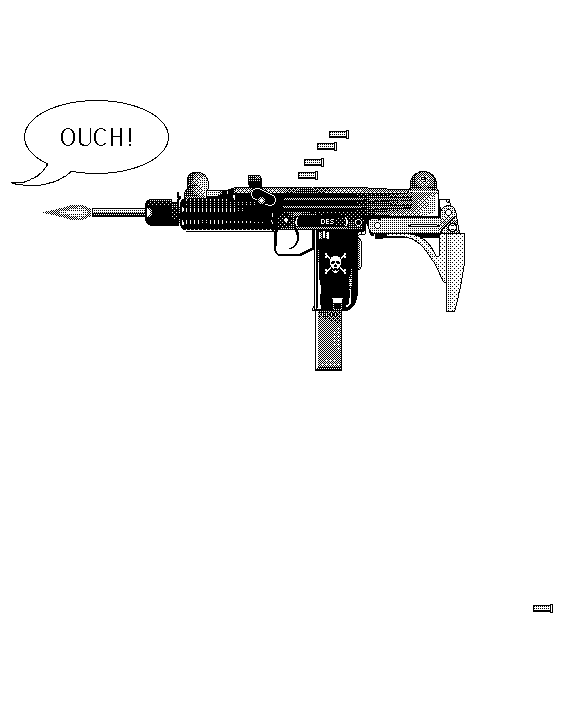
Next, I'll post an original -- yet another futuristic vehicle of war. If I had found in some bookstore 'an illustrated encyclopedia of future vehicles of war,' I would have wet my pants. That's actually not a bad idea for a book, but I would have been more qualified to write it when I was 15 (this drawing was probably made when I was 13 or 14, actually). The title of this image file is 'supertank,' for obvious reasons. That thing in front is, I believe, a device that runs over land mines. I guess you can only use it once (original).
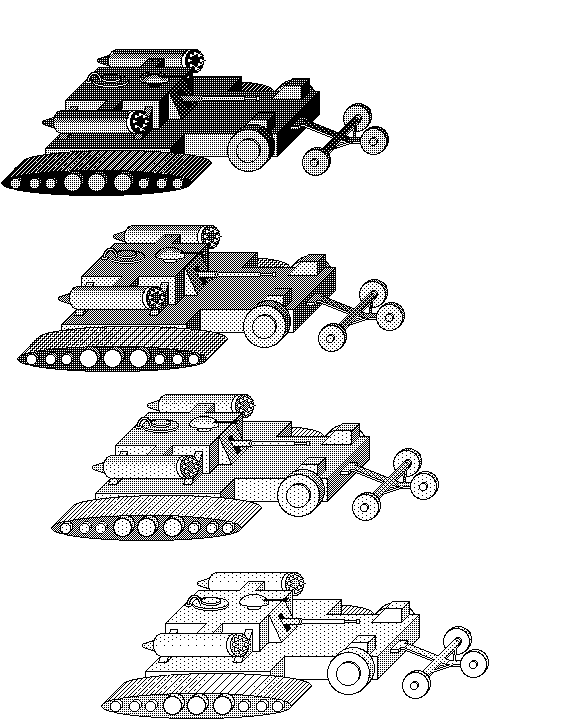
Next is a very early image, probably ca. 1987 or so. It carries a vital sociopolitical message, which I believe was intentionally communicated (original).
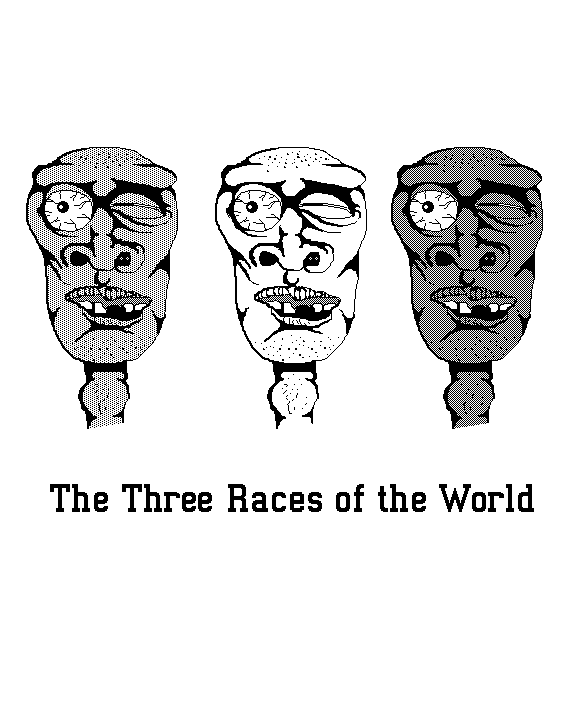
Next is an image file titled 'self portrait.' I loved my mac. Unfortunately, all of my breadbox macs succumbed to hardware failure (the computer in my illustration was actually my father's -- I later acquired a mac plus and later still a performa). My father's (well, the family's) mac was a 512K RAM, 400K floppy, network-unenabled, hard-drive-less, original beige toaster. I never knew the processor speed; mac users aren't concerned with such banalities. Because macintosh computers are so easy to use (or were, rather), and worked so readily out of the box, they encouraged a kind of hardware-stupidity that didnt' manifest in PC users. To make a PC work, one had to (and still has to, to some degree) go through a painful initiation ritual of setting up the right hardware, drivers, settings and software, and then making sure they all work together, often by typing obscure command lines in DOS, reinstalling windows, repeatedly formatting c:, etc. I believe that through this effort, the early (1980s), dedicated PC user's brain was inscribed with a fundamental familiarity with elementary systems analysis and computer engineering that mac users simply didn't have, because they didn't need to. Problem is, this 'under the hood' knowledge and comfort comes in handy, especially now, when operating systems on any platform are as labyrinthine as they have become.
I like to cite a particular example of this 'macintosh syndrome' of abstractions erecting barriers between the user and a deep understanding of machine and software architecture. When I got my OS 9 imac (350mHz, no CD ROM, no disk drive, etc) back in 1999, I put everything on the desktop -- when the 'hard disk' icon was double-clicked, it appeared to be empty (i had no concept of hidden files). So, in terms of the hard disk's tree structure, every single program and document resided in something akin to c:\system\finder\desktop. I didn't see the desktop as just another 'folder,' but as something somehow special. Granted, I'm not sure if this resulted in any confusion for my computer, but I suspect that it might have (it crashed an awful lot).
In essence, the macintosh GUI was so seamless, simple and functional that it led users to believe that that's all there was to it -- that the computer *was* the GUI.
Of course, everything we need to deal with a computer is an abstraction of sorts -- it's just a matter of how many layers of abstraction there are, and how readily these abstractions communicate to the user the ways the 1s and 0s are changing.
Without further ado, here is 'self portrait' (drawn from life).
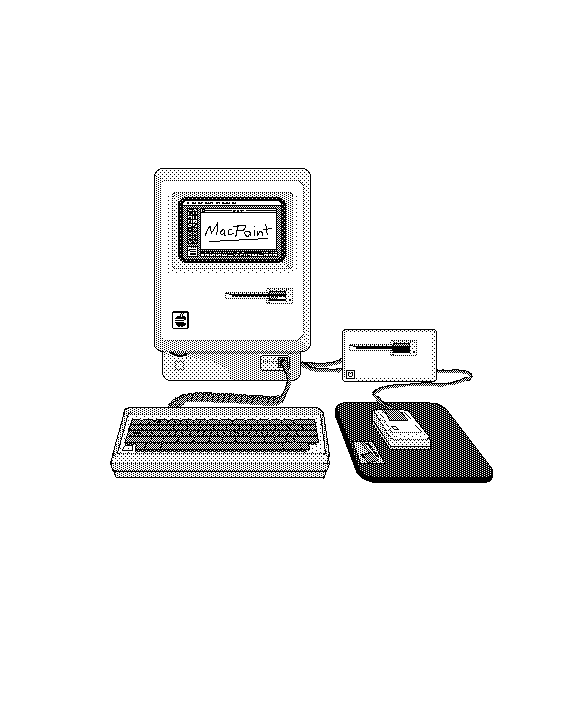
Next is an image from a 4-file series I made called 'aircars: a complete owner's guide (and how to put them to good use), by g'dtlick g'tling.' here we have an example of more futuristic vehicles of warfare, carefully labeled. I copied most of the mechanical parts from various sources.
This was inspired by the roll-playing game 'star frontiers.' again, evidence that I preferred to draw fantasy art related to the game than actually play it (drawn from photos, technical drawings, and a model airplane. Some original elements).
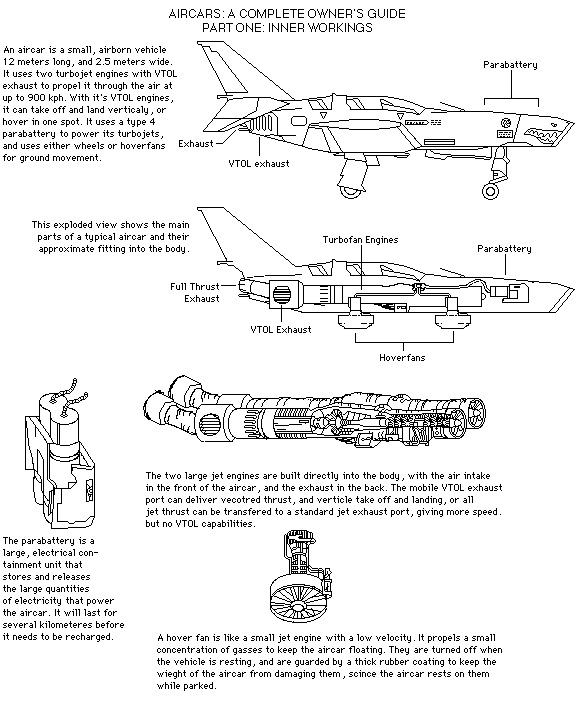
Finally, some player characters from the same game (original, although the concepts for most of the characters were, of course, a product of the roll-playing game).
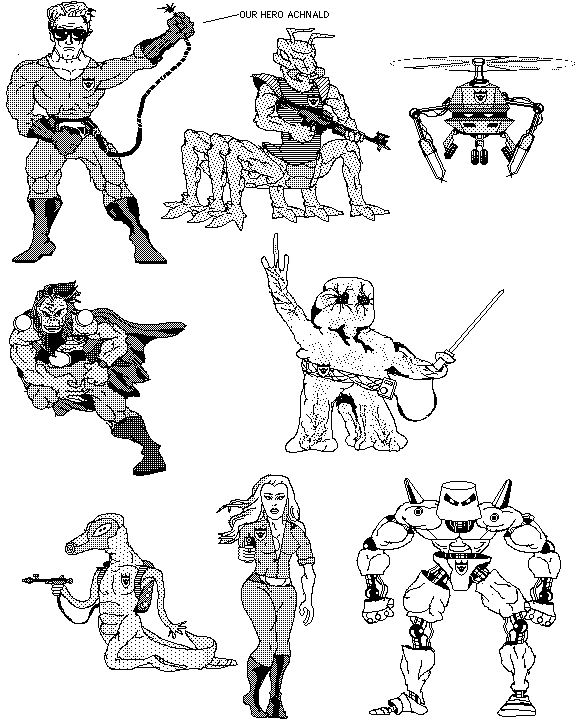
Stay tuned! Tomorrow is 'animation frame day.'
Quite shameful. And yet humorous. The front of an imaginary computer game box (original, although nick may have come up with the concept of 'penal simulator.' I'm only too happy to pass that honor to him).

And the back.
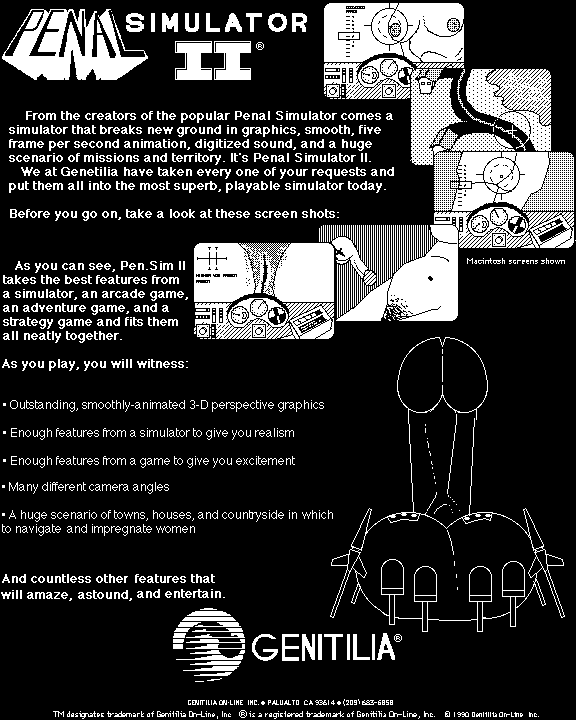
I was probably 14 or 15 when I made this.
It's too rainy to go biking, so I'm forced to sit here all day. Maybe a walk would be good -- it doesn't seem to be coming down or anything, even though the trail around the lake is going to be too wet to enjoy on a bike.
HIRRS finally got back to me, and I'm going to go there on April 7th, resume in hand. I was also asked to supply a coverletter, which I don't quite understand, since I tend to rewrite these based on the job for which I am applying. But whatever. I'll bring my generic 'admin' letter.
I wish it weren't so rainy today.
Highly depressing day. I even had a really ideal night's sleep, and the mood-beneficial effects of this are being nullified by the gloomy weather. I know that I've slept well when I'm able to doze in the mornings. I lie there on the cusp of wakefulness, passing really rapidly in and out of REM state. It's kind of like daydreaming, I think. My brain takes a little while to kick out of sleep-mode, and these morning times of awake-dreaming serve as an ideal transition. If I go to bed at the wrong time, or sometimes just for no reason at all, I'll snap awake at 5am or 7:30am, and not gradually come out of sleep in that way that I like. By brain is generally very sensitive, and is easily disturbed in sleep. What makes it worse is the fact that I feel truly, truly awful for the entire day after a poor night's sleep. Who would have guessed that I'd turn out to be one of those delicate sleepers? I was always immune to the effects of an erratic, non-diurnal sleep schedule when I was younger and my brain was undamaged. I've heard of people with TBIs sleeping as few as 2 or 3 hours a night.
I sort of feel like a nap now.
| if I go to bed at... | I'll be up at... | comments |
| 8:00pm | 2:00am | dont feel too bad upon waking, but I get tired really early in the evening. |
| 9:00pm | 4:00am | same. |
| 10:00pm | 5:00am | same. |
| 11:00pm | 7:30am | optimum time is around here somewhere. There's enough variation so that I'm not 100% sure where, within 10:30 - 11:30, the best time to go to bed is. I've observed that I will often sleep for 7.5 hours the dawn cooperates if I go to bed between 10:30 and 11:30, I can usually do the morning 'dozing' that I like so much -- dreaming while being not quite asleep. |
| 12:00am | 7:30am | feel a bit icky, but nothing devastating |
| 1:00am | 7:30am | ickier |
| 2:00am | 7:30am | feel horrible. Mental fatigue, irritability, sensitive skin, shivers, have to pee and shit all the time, have to sneeze all the time, dry eyes, dry mouth, etc. The worst. |
| 3:00am | 7:30am | beyond horrible |
| 4:00am | 8:00am | not quite as bad, for some reason |
| 5:00am | 8:30am | about the same as the previous |
| 6:00am | 10:00am | here it starts getting weird. If I go to bed after it's gotten light outside, my body won't get kick-started awake by the coming of the dawn, and I'll actually sleep a little better. But the quality of sleep will be fitful, and I'll never be quite awake until my schedule moves back to normal. |
| 7:00am | 12:00pm | same. |
| 8:00am | 2:00pm | same. |
I went to bed at 10:30 last night, and consequently have been awake since 5am.
Today's image will be...hmm...let me go through them. I think the most impressive is my copy of an iron maiden tape cover ('piece of mind'), ca. 1989 (copied from someone else's artork).
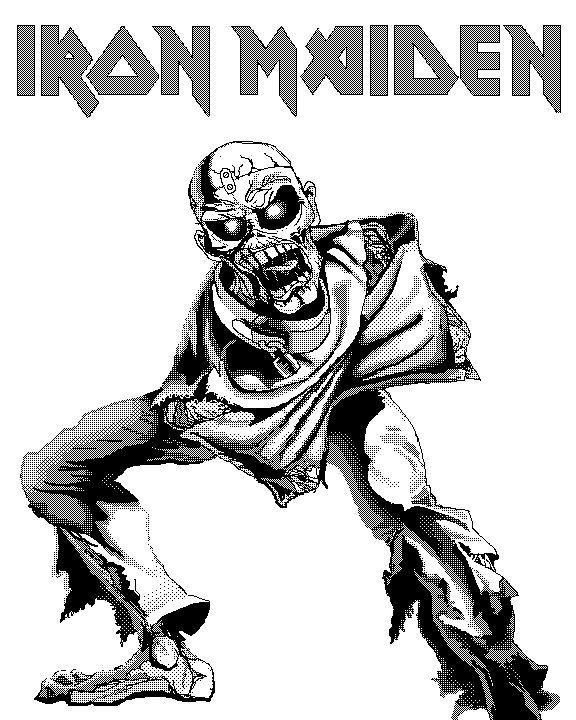
I remember the science of creating elaborately pixeled monochromatic patterns used in generating illusionary greys for shading. There's something nice about monochromatic 'beige toaster' art -- the lack of any colors to work with encouraged insane attention to detail, and pictures drawn in this medium have a unique quality; graphics programs for 1980s macs are to contemporary programs as india ink pens are to watercolors. The images are displayed nicely on today's resolutions, whereas the entire image wasn't viewable on those little 9-inch screens.
Along with still images, I have a few sets of animation frames, drawn for use in videoworks. Videoworks was a 1980s, mac-only animation program, and is the direct ancestor of macromedia director (shockwave). Videoworks was coded, along with musicworks (which I also own) by jamie fenton (formerly jay fenton), a transexual now residing in san francisco. nick emailed her for advice on viewing our old animations, and she promptly replied that she might be able to help, but that nick should 'meow at her again in a week.'
One of nick's and my joint animated videoworks projects was titled 'instant vasectomy' (we thought a 'vasectomy' was a sex change), and involved some demo frames of a walking nude man and woman that were included with the program. Nick and I had the naked man walk across the screen and into a shack labeled 'instant vasectomy.' next, a 'chopping' sound effect is heard, and an animated penis flies out of the shed and through the air. Finally a nude woman emerges from the shed and walks away. Instant vasectomy.
The association of transexuality with videoworks is powerful. Not only did jamie (jay) fenton code the program, but nick and I were compelled to make an animation centered on the same issues. Clearly there were jungian forces at work.
If those old videoworks files turn out to be viewable and 'instant vasectomy' is discovered among them, it will be emailed to jamie fenton as a tribute.
I tried to take a nap today but I couldn't; I just played the guitar instead, before returning to the teat. But I did go for a bike ride today -- I rode around the lake in 28 minutes, my best time yet.
I called the head injury rehab center today for the fourth time, trying to get a hold of their vocational counselor who called me a few days ago to schedule vocational testing. HIRRS is run in the same lackadaisical, parasitic, civil-servant way embraced by most government agencies, which is to be expected since it is a nonprofit organization that gets the bulk of its funding from the government. Tax dollars are funelled into their budget whether they provide snappy, smiley service or not. Ironically, their administrative behavior is sort of reminiscent of a head-injury patient's behavior.
Today's image was selected to showcase exactly how nerdy I was in junior high school. Not only did I play role playing games, but I played 'Star Trek -- the role playing game.' and I drew supplemental technical illustrations. And I drew them on a little breadbox mac. Etc. There's really no turning back at this point (i think at least one of the ships might be original, conceived in the style of a Star Trek vessel).
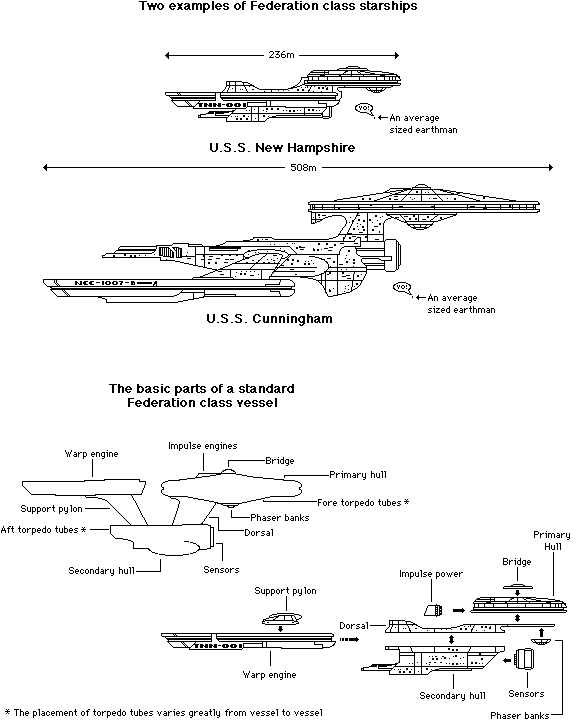
Remember, the placement of torpedo tubes varies greatly from vessel to vessel. It's a common beginner's mistake to say 'hey...I'm familiar with the placement of the torpedo tubes on the new hampshire...I'll just assume they're in the same place on the cunningham.' WRONG.
Nick bought an old macintosh classic for $20 on ebay, and the two of us went through my old mac disks the other day, discovering a lot of my old artwork (there were a few joint projects, namely animations, but those are proving more difficult to extract). Here is the first image that he's managed to salvage and make readable (original).
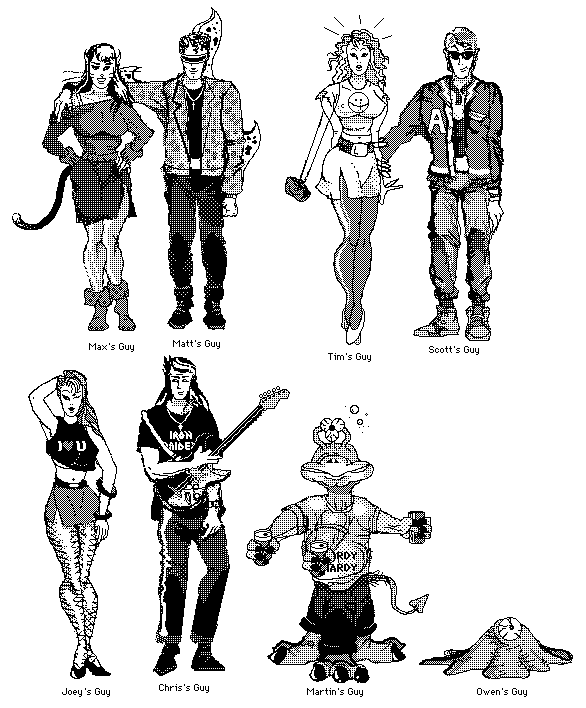
In seventh and eigth grade, I was into role playing games. Not so much playing them, which was sort of unsatisfying save for the company of fellow nerds and a bag of doritos, but drawing pictures of characters, maps, weapons, vehicles, etc. The above example comprises characters from a game called 'teenagers from outer space.' it's funny how social outcasts often supplant sexual frustration into creating female characters, drawing cartoon women (as in my case), etc. What's even more disturbing is that some of my friends' characters of appropriate genders were 'dating' each other, like mine and max's. At least I got to be the man.
This was in the era before cheap and widely available scanners, and so was drawn using the mouse like a pencil, often with the image zoomed in 5x or so. I remember those heady days of mouse-dexterity; people often didn't believe me when I told them I'd actually drawn images like these. But really, drawing with a mouse isn't any more difficult or amazing than drawing with a pencil, gum eraser, set of pens, airbrush and mask -- it just takes some getting used to.
Going through some of my old artwork I found a couple of daily schedules I made when I was 12, in the summer between 6th and 7th grade and then during the 7th grade school year. In case the writing is illegible, a transcription immediately follows the schedules. I also posted an example of some other artwork done during that period, to help communicate some points about my psychology.
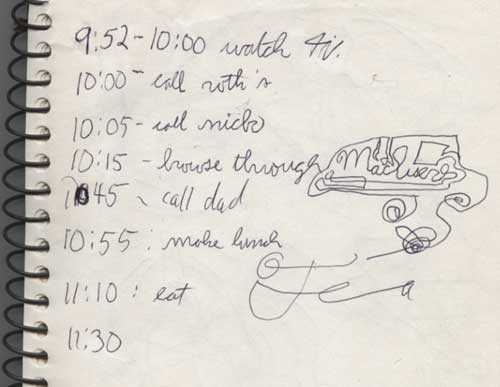
9:52 - 10:00 watch tv
10:00 - call roth's
10:05 - call nick
10:15 - browse through Macusers
10 45 - call dad
10:55 : make lunch
11:10 : eat
11:30
I assume the significance of 9:52 is that this was the time I started on my schedule (i didn't allow any time for schedule-making, a problem that was corrected in later schedules). 'roth's' was the local movie theater (the property is now occupied by 'shadowlands,' a photon or laser tag-like arena), where I would sometimes go to see summer movies by myself. The nick whom I was supposed to call at 10:05 is the same nick I still hang around with today. 'macuser' is a macintosh magazine to which my dad subscribed; I'm not sure about the doodling surround the word. I think that says 'tea' in the lower right corner, but I'm not sure why. I believe the 11:30 time was given to indicate when lunch would be over, but that's apparently as far ahead as I wanted to plan.
It's interesting to note that the dash separating the time and the event was replaced with a semicolon after 'call dad.' also note the first entry, 'watch tv,' and it's lack of a dash separating numbers from words. I believe this was because the dash was used to indicate the span of 9:52 - 10:00, and another dash so soon after would have been visually unacceptable. I could have written '9:52 - watch tv,' and have the end of that slot indicated by the beginning of the next ('call roth's), but I didn't think to. I began with the 'chunk of time' format, with blocks of time indicated for each activity. But after the first item, 'chunk of time' format deviated to 'start and stop' format, in which the end of one activity is implied by the beginning of another (5 minutes alloted for calling roth's, 10 for calling nick, etc). I don't think this schedule was followed very closely, if at all.
Here is the second schedule, made during the 7th grade school year.
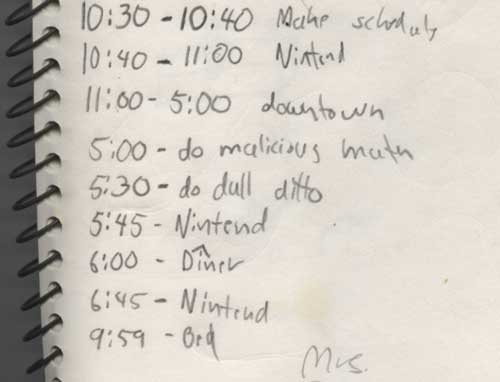
10:30 - 10:40 Make schedule
10:40 - 11:00 Nintend
11:00 - 5:00 downtown
5:00 - do malicious math
5:30 - do dull ditto
5:45 - Nintend
6:00 - Dîner
6:45 - Nintend
9:59 - Bed
Notable about this schedule is the 10-minute allotment for making the schedule itself, the coined verb 'to nintend' (to play nintendo), going downtown (where, specifically, in 'downtown'? 'downtown' gaithersburg? DC? To accomplish what? With whom?), the onomatopoeic adjectives modifying my homework assignments, the french word for 'dinner' (complete with circumflex) and bedtime at 9:59. Nick speculated that the rule might have been 'in bed before 10.'
In the same pile of old artwork were some really detailed technical drawings, dating to approximately the same era as the schedule. I had drawn space ships, military vehicles, weapons, etc, with all of their parts and inner workings carefully labeled. I think this meticulous schedule was born of the same impulse; I liked to label and categorize things, to control reality with verbal categories. I was also desperately trying to fill my time during summer vacation, a time that used to be pretty boring for me. For three months I essentially sat by myself and watched TV: I love lucy, old Star Trek episodes, bewitched, I dream of genie, thundercats, voltron, etc. I was a weird, extremely nerdy little kid. I might have been diagnosed with
Here's an example of a drawing from that era.
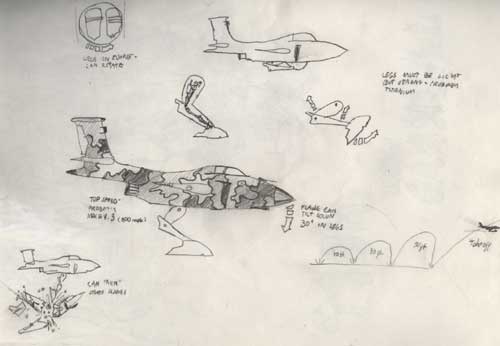
This was an idea inspired by the 1982 skirmish between argentina and the uk over the falkland islands, off the coast of south america). I owned a game called 'harrier jump jet' in which the player took off from an aircraft carrier and bombed an island. I thought it would be funny if the 'jump jet' were literally a jump-jet. Haha. You can barely see it, but note the takeoff procedure (lower right), which visually describes the plane bouncing higher and higher on the runway until it flies.